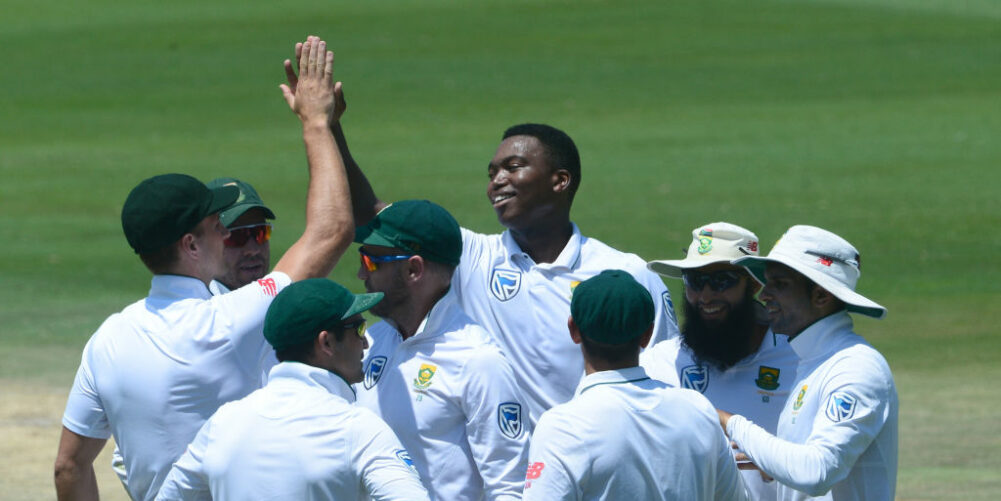(Photo: Getty Images)
By Neil Manthorp
Hilton College, in the Natal Midlands close to Pietermaritzburg, was founded in 1872 and moulded in the fashion of the classical English public school, specifically Rugby College, the alma mater of its first headmaster.
It has a rich and proud sporting history having produced a clutch of Springbok rugby players including recent captains Bob Skinstad and Gary Teichmann.
Its cricketing pedigree isn’t so strong although Mike Procter will remain its most famous product for some time to come. Depending on how well the career of Lungisani Ngidi progresses over the next decade or so.
The 21-year-old fast bowler burst onto the international scene in spectacular fashion this week with a man-of-the-match winning performance of 6-39 to sink India by 135 runs in the second Test in Centurion and help South Africa to an unassailable 2-0 lead with the final Test starting at the Wanderers next Wednesday.
Ngidi, whose father is a buildings caretaker and mother a domestic worker, was awarded a scholarship to Hilton but only started playing seriously at the age of 15 when he immediately caught the attention of 1st XI coach Neil Johnson, the former Zimbabwe, Hampshire and Leicestershire all-rounder who alerted the Titans to his potential.
He was reluctant to move to Pretoria after school having rarely travelled outside his native Durban and was only persuaded with the promise of a place at Tuks University where he enrolled in a Bachelor of Social Sciences degree in Industrial Sociology: “I wanted to further my education, not really knowing whether I could make a career in cricket,” he explained. “But they gave me the chance to do both.”
His willingness to work hard off the field was matched by a tireless dedication to improvement on it and when he linked up with Titans head coach, Mark Boucher, last year, it became obvious that he was destined for a quick rise to the top.
He made his T20 International debut a year ago but was stalled by a couple of injuries. Boucher was in no rush to get him back on the field: “He needs to be taken care of. He is special, he could play for the Proteas for many years to come, but there is no hurry,” Boucher said three weeks ago when Ngidi was, apparently, nowhere near the national squad.
But then Dale Steyn was injured and, with two Tests to go against India and four more against Australia in March, head coach Ottis Gibson decided to have a first hand look at the nation’s fast bowling reserves. So Ngidi was invited to join the squad in the build-up to last week’s Test.
Not only had Gibson never seen him bowl in the flesh, neither had national captain Faf du Plessis until two days before the Test match. Neither man had any intention of playing him. They had been told by the Titans people that he “wasn’t ready for Test cricket”. And then they saw him, and that was that.
“I loved what I saw in the nets, but I like to look at what is inside a person first,” said du Plessis after the victory, “and it is obvious that Lungi is a very special, humble human being.”
Unlike the sinewy strength and athletic builds of Makhaya Ntini and Kagiso Rabada, Ngidi is more powerfully built, more Patrick Patterson than Malcolm Marshall. But he moves smoothly to the crease, relying on the strength in his thighs and glutes and broad shoulders to generate pace which peaked at 145kph. His Titans teammates say there is more in the tank.
The symbolic importance in South Africa of seeing two black African fast bowlers winning a Test on the final day cannot be overstated. Transformation quotas continue to be a painful and divisive issue in the country, but only when there is selection contention.

When one bowler is ranked number one in the world and the other is destroying India’s rearguard innings, the unfettered happiness, from every colour and creed, is as much a reflection of the desire not to need quotas as it is a celebration of victory.
The irony is that Rabada and Ngidi come from opposite ends of the privilege spectrum, originally. The former grew up in a wealthy Johannesburg suburb with a brain surgeon and investment analyst as parents, the latter in “a very humble background”, in his own words. Both went to expensive (mostly white) private schools and have the trademark accents and etiquette to show for it. So different, and so similar.
Ngidi immediately picked out the second innings wicket of Virat Kohli as his favourite, but was more cautious about his long-term goals, hesitant about the perils of getting ahead of himself.
“A long career would be nice.”
And Rabada, just a year older and already number one in the world?
“I’m so proud of him, he’s already a role model for millions of South Africans. I’d love to emulate his achievement one day but, for now, I’m just happy to be chasing him.”
There are more Ngidi diamonds out there. South African cricket is, and always will, produce more prime assets than it can use. Such is the school and club structure. England and New Zealand should refine their catchment process rather than deny it.












